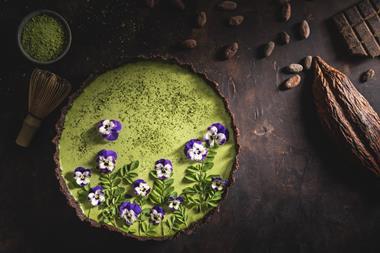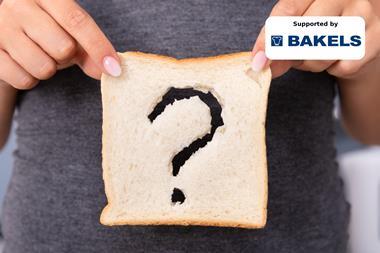Botanicals such as flowers and tea are gaining traction in bakery as Brits seek similar flavours to those found in their beloved gin and tonics.
Florals? For Spring? Ground-breaking.” As villain Miranda Priestley points out in the movie The Devil Wears Prada, using florals in spring – whether in fashion or bakery – isn’t exactly original. But introducing lesser-known florals in bakery presents an opportunity for trend-setting.
Flavours such as rose, lavender and violet have been favourites for decades but interest in more unusual botanicals has boomed in recent years thanks, in part, to a surge in the popularity of gin and tonic.
“This trend started to influence flavour innovation in the wider beverage category and now it’s the turn of the bakery category as consumers start to prefer flavour over sweetness,” believes Hugh Evans, marketing manager, Synergy Flavours.
Analyst Mintel identifies elderflower, rose and hibiscus as the top three floral flavours in new product launches across Europe. However, bakery flavour experts tip orange blossom, geranium and bergamot as the ones to watch this year.
“Chrysanthemum and bergamot are often overlooked. Chrysanthemum, especially, has some lovely notes if you capture the sweetness and remove some of the stronger floral notes,” says Dave Twiss, managing director at House of Flavours.
Sweetness, explains Macphie senior category marketing manager Anna Massie, is important as consumers seek a sweet hit without the sugar that often accompanies it. “There is a sweetness, but a more complex taste than you get with sugar alone,” she says.
Japanese flavours are also tipped to blossom as the 2020 Tokyo Olympics draw near. “We may start to see popular Japanese florals like cherry blossom or chrysanthemum emerge,” adds Evans.
Dawn Foods also has its eye on flavours with Asian provenance. “Now that matcha and green tea are accepted flavours, delicate Asian flavours from teas, such as jasmine and white tea, could become more popular,” notes marketing manager Jacqui Passmore.
The tea trend has been embraced by Fortnum & Mason, which unveiled Teacup Fancies in 2018, with rose pouchong and countess grey teas used as flavourings.
But baking with botanicals has its challenges, particularly when it comes to using fresh and dried ingredients.
“Fresh ingredients are quite mild and need to be added in quite high levels for flavours to be recognisable,” notes Andrew Hughes, baking technology manager at Campden BRI. However, as the water content can be higher than the dough or batter, changes may occur to the final product.
Dried ingredients, meanwhile, present their own challenges as the process of drying is often quite uncontrolled, resulting in products that have inconsistent flavours, he adds.
Instead, Hughes suggests turning to extracts. Due to the concentration of flavour, they are often used in much lower volumes than fresh or dried ingredients and are therefore unlikely to change the colour, texture or appearance of the bakery product.
Synergy’s Evans, meanwhile, suggests using the botanicals to flavour toppings, decorations and inclusions rather than in the baked product itself.
“Due to their naturally subtle flavour, we find that botanicals perform best when they can be added into the other elements of the bake, such as the icing or the fruit preparation. This allows them to be used at a much lower level,” he says.
It also helps keeps cost down, as House of Flavours’ Twiss notes that using botanicals can be quite expensive. “However, we see this kind of development mainly at the luxury end of the market where there is more flexibility in cost drivers,” he says.
Rosewater and Pistachio Battenburg
INGREDIENTS
- Macphie Vegan Cake Mix, 1kg
- Rosewater flavour, 15g
- Vegetable oil, 170g
- Pink colouring
- Water, 370g
- Green colouring
- Glycerine, 30g
- Vegan suitable jam
- Vegan suitable marzipan
- Pistachios (Chopped)
METHOD
- Mix Vegan Cake Mix and liquids (except colourings and jam) on slow speed for one minute, then middle speed for six minutes.
- Divide batter in two (785g), colour half pink and other green.
- Lightly grease 2 x (7” x 12”) foil trays and scrape in each batter.
- Bake at 180°C for 30-35 mins.
- Jam two sheets together and cut into strips. Alternate strips and jam together, coat outside with jam and roll in marzipan.
- Decorate with pistachios.
Source: Macphie
Lemon & Violet Cake
INGREDIENTS
- Dawn Golden Genoese, 750g
- Dawn Lemon Frosting, 1.5kg
- Dawn Vanilla Frosting, 200g
- Water, 300g (1)
- Vegetable oil, 75g
- Water, 130g (2)
- Violet/purple food colour (as required)
- Violet flavour, 12g
- Small violet flowers
METHOD FOR CAKE
- Add the Golden Genoese, water (1), vegetable oil, colour and flavour to a mixing bowl fitted with a beater and mix for 1 minute on slow speed and then 4 minutes on medium speed.
- While mixing on slow speed, stream in water (2), scrape down and then continue to mix on slow speed for a further 1 minute.
- Deposit 400g into prepared 8” round tins.
- Bake at 180˚C for approximately 30 minutes.
METHOD FOR FROSTING
Mix the vanilla frosting and violet colour together to create the required colour for the band around the cake.
ASSEMBLY
- Trim the tops of the three sponges to make level.
- Sandwich them together with lemon frosting.
- Coat the top and then the top and bottom 1/3 sides of the cake with more lemon frosting.
- Coat the middle 1/3 of the sides with the prepared violet coloured frosting.
- Smooth the top and the sides to smooth out and blend the colours on the sides.
- Decorate with fresh flowers.
Source: Dawn Foods





























No comments yet